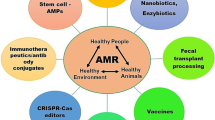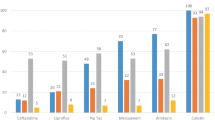Abstract
Antimicrobial resistance (AMR) is considered the silent pandemic that threatens the global public health systems and one of the biggest threats to global health, food security, and development. The emerging crisis of antimicrobial resistance is largely man-made from overuse of antibiotics in humans and animals. This chapter reviews the current status of antimicrobial resistance globally and the mechanisms by which bacteria resist antibiotics. AMR is a natural evolutionary process which predated the discovery of penicillin and allows survival of the fittest through natural selection. However, the “antibiotic pressure” driving the dynamics of AMR is largely “man-made.” Although AMR is most commonly recognized in enteric bacteria (Enterobacteriaceae) and skin flora (methicillin-resistant S. aureus), it is a threat to the global design to eradicate or control tuberculosis (multidrug-resistant and extensively drug-resistant M. tuberculosis) and malaria (artemisinin-resistant P. falciparum), certain viral infections (cytomegalovirus and human immunodeficiency virus), and specific fungal opportunistic pathogens (Candida nonalbicans and Aspergillus sp.).
It is estimated that 700,000 deaths occur yearly in the world from AMR infections and projected to escalate to ten million by 2050, if drastic global control measures are not instituted. In the United States, multidrug-resistant bacteria infections account for >20% hospitalization annually, and > 80% are community derived. The economic impact of AMR infections are huge and without immediate actions to find solutions and could result in increase in global poverty, shortage of meat, widespread unemployment, and decline in gross national product of numerous countries (greater in low-middle-income nations).
Access this chapter
Tax calculation will be finalised at checkout
Purchases are for personal use only
Similar content being viewed by others
References
D’Costa VM, King CE, Kalan L, et al. Antibiotic resistance is ancient. Nature. 2011;477:457–61.
Klein EY, Van Boeckel TP, Martinez EM, et al. Global increase and geographic convergence in antibiotic consumption between 2000 and 2015. Proc Natl Acad Sci USA. 2018;115:E3463–70.
Van Boeckel TP, Browser C, Gilbert M, et al. Global trends in antimicrobial use in food animal. Proc Natl Acad Sci U S A. 2015;112:5649–54.
Food and Agriculture Organization of the United Nation. (2017). http://www.fao.org/faostat/en/#home
Van Boeckel TP, Pires J, Silvester R, et al. Global trends in antimicrobial resistance in animals in low-and middle-income countries. Science. 2019;365:eaaw1944.
European Food Safety Authority and European Centre for Disease Prevention and Control. The European Union summary report on antimicrobial resistance in zoonotic and indicator bacteria from humans, animals and food in 2016. EFSA J. 2018; https://doi.org/10.2903/j.efsa.2018.5182.
Ward MJ, et al. Time-scaled evolutionary analysis of the transmission and antibiotic resistance dynamics of Staphylococcus aureus clonal complex 398. Appl Environ Microbiol. 2014;80:7275–82.
De Vries SPW, et al. Phylogenetic analysis and antimicrobial resistance profiles of Campylobacter spp. from diarrheal patients and chickens in Botswana. PLoS One. 2018;13:e0194481.
Liu YY, et al. Emergence of plasmid –mediated colistin resistance mechanisms MCR-1 in animals and human beings in China: a microbiological and molecular biological study. Lancet Infecty Dis. 2016;16:161–8.
Tang KL, Caffrey NP, Nobrega DB, et al. Restricting the use of antibiotics in food-producing animals and its association with antibiotic resistance in food-producing animals and human beings: a systematic review and meta-analysis. Lancet Planet Health. 2017;1:e316–27.
Van Bunnik B, Woolhouse M. Modeling the impact of curtailing antibiotic usage in food animals on antibiotic resistance in humans. R Soc Open Sci. 2017;4:161067.
Forsman M, Haggerstrom B, Lindgren L, Jaurin B. Molecular analysis of β-lactamases from four species of Streptomyces: comparison of amino acid sequences with those of other β-lactamases. Microbiology. 1990;136:589–98.
Ogawara H, Kawamura N, Kudo T, Suzuki K-L, Nakase T. Distribution of β-lactamases in actinomycetes. Antimicrob Agents Chemother. 1999;43:3014–7.
Livermore D, Canton R, Gniadkowski M, et al. CXT-M changing the face of ESBLs in Europe. J Antimicrob Chemother. 2007;59:165–74.
Davies J, Davies D. Origins and evolution of antibiotic resistance. Microbiol Molecular Biol Rev. 2010;74:417–33.
Liu B, Pop M. ARDB—antibiotic resistance genes database. Nucleic Acid Res. 2009;37:D443–7.
Forsberg KJ, Patel S, Gibson MK, Lauber CL, Knight R, Fierer N, Daniels G. Bacterial phylogeny structure soil r5esistomes across habitats. Nature. 2014;509:612–6.
Etienne R, Ghozlane A, Tap J, et al. Prediction of the intestinal resistome by a three-dimensional structure-based method. Nat Microbiol. 2018; https://doi.org/10.1038/s41564-018-0292-6.
Willems RPJ, van Dijk K, Ket JCF, Vanderdroucke-Grauls CMJE. Evaluation of the association between gastric acid suppression and risk of intestinal colonization with multi-resistant microorganisms. A systematic review and meta-analysis. JAMA Intern Med. 2020; https://doi.org/10.1001/jamaiternmed.2020.0009.
Kapoor G, Saigal S, Elongavan A. Action and resistance mechanisms of antibiotics: a guide for clinicians. J Anaesthesiol Clin Pharmacol. 2017;33:300–5.
Eyal Z, Matzov D, Krupkin M, et al. A novel pleuromutilin antibacterial compound, its binding mode and selectivity mechanisms. Sci Rep. 2016;6:1–8.
Zaman SB, Hussain MA, Nye R, Mehta V, Mamun KT, Hossain N. A review on antibiotic resistance: alarm bells are ringing. Cureus. 2017;9:e1403.
Lambert PA. Cellular impermeability and uptake of biocides and antibiotics in gram-positive bacteria and mycobacteria. J Appl Microbiol. 2002;92(Suppl):46S. 54S.
Tenover FC. Mechanisms of antimicrobial resistance in bacteria. Am J Med. 2006;119(6 Suppl 1):S3–10.
Grundmann H, Aires-de-Sousa M, Boyce J, Tiemersma E. Emergence and resurgence of methicillin-resistant Staphylococcus aureus as a public health threat. Lancet. 2006;368:874–85.
Giedraitiene A, Vikauskiene A, Naginiene R, Pavilonis A. Antibiotic resistance mechanisms of clinically important bacteria. Medicina (Kaunas). 2011;47:137–46.
Higgins PG, Fluit AC, Schmitz FJ. Fluoroquinolones: structure and target sites. Curr Drug Targets. 2003;4:181–90.
Peterson E, Kaur P. Antibiotic resistance mechanisms in bacteria: relationship between resistance determinants of antibiotic producers, environmental bacteria, and clinical pathogens. Front Microbiol. 2018; https://doi.org/10.3389/fmicb.2018.02928.
Mojica MF, Bonomo RA, Fasi W. B1-metallo-beta lactamases: where do we stand? Curr Drug Targets. 2016;17:1029–50.
Perez F, Endimiani A, Hujer KM, Bonomo RA. The continuing challenge of ESBLs. Curr Opin Pharmacol. 2007;7:459–69.
Wright GD. Q & A: antibiotic resistance: where does it come from and what can we do about it? BMC Biol. 2010;8:123.
McMurry L, Petrucci RE Jr, Levy SB. Active efflux of tetracycline encoded by four genetically different tetracycline resistance determinants in Escherichia coli. Proc Natl Acad Sci USA. 1980;77:3974–7.
Nikaido H, Takatsuka Y. Mechanisms of RND multidrug efflux pumps. Biochem Biophys Acta. 2009;1794:769–81.
Van Bambeke F, Michot JM, Tulkens PM. Antibiotic efflux pumps in eukaryotic cells: occurrence and impact on antibiotic cellular pharmacokinetics, pharmacodynamics and toxicodynamics. J Antimicrob Chemother. 2003;51:1067–77.
Blanco P, Hernando-Amado S, Reales-Calderon J, et al. Bacterial multidrug efflux pumps: much more than antibiotic resistance determinants. Microorganisms. 2016;4:14. https://doi.org/10.3390/microorganisms4010014.
Fernandez L, Breidenstein EB, Hancock RE. Creping baselines and adaptive resistance to antibiotics. Drug Resis Updates. 2011;14:1–21.
Anderson D, Hughes D. Selection and transmission of antibiotic resistant bacteria. Microbiol Spectr. 2017;5:1–17.
D’Costa VM, McGrann KM, Hughes DW, Wright GD. Sampling the antibiotic resistome. Science. 2006;311:374–7.
Dantas G, Summer MOA, Oluwasegun RD, Church GM. Bacteria subsisting on antibiotic. Science. 2008;320:100–3.
Woodford N, Ellington MJ. The emergence of antibiotic resistant by mutation. Clin Microbiol Infect. 2007;13:5–18.
Schrag SJ, Perrot V, Levin BR. Adaptation to the fitness costs of antibiotic resistance in Escherichia coli. Proc R Soc Lond B Biol Sci. 1997;264:1287–91.
Poole K. Multidrug efflux pumps and antimicrobial resistance in Pseudomonas aeruginosa and related organisms. J Med Microbiol Biotechnol. 2001;3:255–64.
Heritage J, M’Zali FH, Gascoyne-Binzi D, HawKey PM. Evolution and spread of SHV extended-spectrum β-lactamases in gram-negative bacteria. J Antimicrob Chemother. 1999;44:309–18.
Huddleston JR. Horizontal gene transfer in the human gastrointestinal tract: potential spread of antibiotic genes. Infect Drug Resis. 2014;7:167–76.
Arcilla MS, van Hattem JM, Matamoros S, et al. Dissemination of themer-1colistin resistance gene. Lancet Infect Dis. 2015;16:147–9.
von Wintersdorff CJH, Penders J, van Niekerk JM, et al. Dissemination of antimicrobial resistance in microbial ecosystem through horizontal gene transfer. Front Microbiol. 2016; https://doi.org/10.3389/fmicb.2016.00173.
Domingues S, Harms K, Fricke WF, Johnsen PJ, da Silva GJ, Nielsen KM. Natural transformation facilitates transfer of transposons, integrons and gene cassettes between bacterial species. PLoS Pathog. 2012;8:e1002837. https://doi.org/10.1371/journal.ppat.1002837.
Friedman ND, Temkin E, Carmeli Y. The negative impact of antibiotic resistance. Clin Microbiol Infect. 2016;22:416–22.
O’Neill J. Tackling drug-resistant infections globally: final report and recommendations. Review Antimicrob. Resistance 2016; https://amr-review.org/. Accessed 17 Apr 2020.
Centers for Disease Control and Prevention. Antibiotic resistance threats in the United States. 2013; https://www.cdc.gov/drugresistance/threat-report-2013/pdf/ar-threats-2013-508-pdf
Jernigan JA, Kelly M, Hatfield MSPH, et al. Multidrug–resistant bacterial infections in US hospitalized patients, 2012–2017. N Engl J Med. 2020;382:1309–19.
Antony HA, Parija SC. Antimalarial drug resistance: an overview. Trop Parasitol. 2016;6:30–41.
Prestinaci F, Pezzotti P, Pantosti A. Antimicrobial resistance: a global multifaceted phenomenon. Pathog Glob Health. 2015;109:309.
Chokshi A, Sifri Z, Cennimo D, Horng H. Global contributors to antibiotic resistance. J Glob Infect Dis. 2019;11:36–42.
Shrestha P, Cooper BS, Coast J, et al. Enumerating the economic cost of antimicrobial resistance per antibiotic consumed to inform the evaluation of interventions affecting their use. Antimicrob Resist Infect Control. 2018;7:98. https://doi.org/10.1186/s13756-018-0384-3.
Thorpe KE, Joski P, Johnston KJ. Antibiotic-resistant infection treatment costs have doubled since 2002, now exceeding $2 billion annually. Health Aff. 2018;37:662–9.
Asiam B, Wang W, Arshad MI, et al. Antibiotic resistance: a rundown of a global crisis. Infect Drug Resist. 2018;11:1645–58.
Drug-resistant infections a threat to our economic future; 2017. Available from: www.worldbank.org. Accessed 21 Apr 2020.
Antibiotic resistance threats in the United States, 2013. https://www.cdc.gov/drugresistance/pdf/ar-threats-2013-508.pdf. Accessed 21 Apr 2020.
Anderson M, Clift C, Schulze K, et al. Health systems and policy analysis- averting the AMR crisis: what avenues for policy. Eur Obs Heal Sys Policies. 2019; [Google Scholar]
Utt E, Wells C. The global response to the threat of antimicrobial resistance and the important role of vaccines. Pharm Policy Law. 2016;18:179–97. https://doi.org/10.3233/PPL-160442.
Dadgostar P. Antimicrobial resistance: implications and costs. Infect Drug Resist. 2019;12:3903–10.
Animal production I antimicrobial resistance I food and agriculture organization of the United Nations. http://www.fao.org/antimicrobial-resistance/key-sectors/animal-production/en/
Buchy P, Ascioglu S, Buisson Y, et al. Impact of vaccines on antimicrobial resistance. Int J Infect Dis. 2020;90:188–96.
Hicks LA, Bartoces MG, Roberts RM, et al. US outpatient antibiotic prescribing variation according to geography, patient population, and provider speciality in 2011. Clin Infect Dis. 2015;60:1308–16.
Linder JA, Meeker D, Fox CR, Friedberg MW, Persell SD, Goldstein NJ, Doctor JN. Effects of behavioral interventions on inappropriate antibiotic prescribing in primary care 12 months after stopping the interventions. JAMA. 2017;318:1391.
Daneman N, Gruneir A, Newman A, et al. Antibiotic use in long-term care facilities. J Antimicrob Chemother. 2011;66:2856–63.
Rhee SM, Stone ND. Antimicrobial stewardship in long-term care facilities. Infect Dis Clin N Am. 2014;28:237–46.
US Food and Drug Administration. Battle of the bugs: fighting the antibiotic resistance. Updated May 4, 2016.; https://www.fda.gov//drugs/resourcesforyou/consumers/ucm43568.htm
Briceland LL, Nightingale CH, Quintiliani R, et al. Antibiotic streamlining from combination therapy to monotherapy utilizing an interdisciplinary approach. Arch Intern Med. 1988;148:2019–22.
Owens RC. Antimicrobial stewardship: concepts and strategies in the 21st century. Diag Microbiol Infect Dis. 2008;61:110–28.
Davey P, Marwick CA, Scott CL, et al. Interventions to improve antibiotic practices for hospital inpatients. Cochrane Database Syst Rev. 2017;2:CD003543. https://doi.org/10.1002/14651858.CD003543.pub4.
Nathwani D, Varghese D, Stephens J, Ansari W, Martin S, Charbonneau C. Value of hospital antimicrobial stewardship programs [ASPs]: a systemic review. Antimicrob Resist Infect Control. 2019;8:35. https://doi.org/10.1186/s13756-019-0471-0.
Vaughn VM, Flanders SA, Snyder A, et al. Excess antibiotic treatment duration and adverse events in patients hospitalized with pneumonia. Ann Intern Med. 2019;171:153–63.
Manyi-Loh C, Mamphwell S, Meyer E, Okoh A. Antibiotic use in agriculture and its consequential resistance in environmental sources: potential public health implications. Molecules. 2018;23:795. https://doi.org/10.3390/molecules23040795.
Author information
Authors and Affiliations
Corresponding author
Rights and permissions
Copyright information
© 2023 The Author(s), under exclusive license to Springer Nature Switzerland AG
About this chapter
Cite this chapter
Fong, I.W. (2023). Antimicrobial Resistance: A Crisis in the Making. In: New Antimicrobials: For the Present and the Future. Emerging Infectious Diseases of the 21st Century. Springer, Cham. https://doi.org/10.1007/978-3-031-26078-0_1
Download citation
DOI: https://doi.org/10.1007/978-3-031-26078-0_1
Published:
Publisher Name: Springer, Cham
Print ISBN: 978-3-031-26077-3
Online ISBN: 978-3-031-26078-0
eBook Packages: MedicineMedicine (R0)




